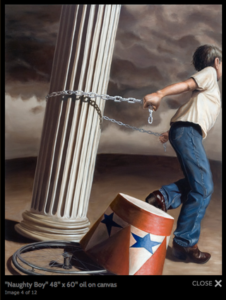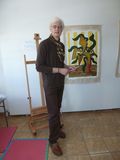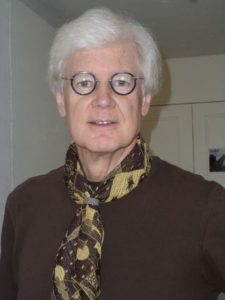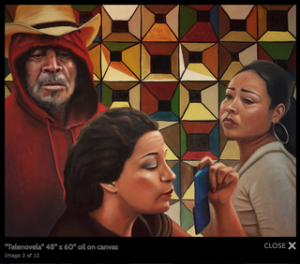
You were the first oil painter here at 360 Xochi Quetzal. Give us some background about your development as an artist, and your influences.
 Making art is something that I have come to later in life. Despite having a very successful business career, I found myself feeling miserable in my 40’s. With some professional help, I uncovered the fact that I had been repressing an interest in the creative arts. Then, in an introductory drawing class, I also discovered that I might actually have some artistic talent. I began taking classes, more and more over time, which eventually led me to graduate art school, where I focused on oil painting. Since graduating in 2007, I have been working to develop my voice as an artist and find what place I want to occupy in the art world. In this exploration, I have produced two very different series of works – one of complex narratives aimed at the collector market using realism,the figure and supporting iconography; and the other aimed at the decorator market creating unconventional, modern interpretations of a conventional, traditional subject: the still life.
Making art is something that I have come to later in life. Despite having a very successful business career, I found myself feeling miserable in my 40’s. With some professional help, I uncovered the fact that I had been repressing an interest in the creative arts. Then, in an introductory drawing class, I also discovered that I might actually have some artistic talent. I began taking classes, more and more over time, which eventually led me to graduate art school, where I focused on oil painting. Since graduating in 2007, I have been working to develop my voice as an artist and find what place I want to occupy in the art world. In this exploration, I have produced two very different series of works – one of complex narratives aimed at the collector market using realism,the figure and supporting iconography; and the other aimed at the decorator market creating unconventional, modern interpretations of a conventional, traditional subject: the still life.
My influences for these two lines of work have been very different. All the artists whose work I admire have strong technical skills in common. For the figurative work, I have studied both modern and classical masters. Modern favorites include Vincent Desiderio, Odd Nerdrum, JulioLarraz, Edward Hopper, Komar and Melamid, and Neo Rauch. Among the classical masters, my favorites are Reubens, Van Dyck, Rembrandt, and Caravaggio – I especially love the Baroque era for the depiction of drama and intensity.
 For inspiration in my contemporary still life inventions, I must first genuflect at the feet of Picasso. His innovations remain fresh and exciting all these years later, as do the creations of Stuart Davis, whose work has a deceptively simple elegance. I also try to channel the energy and fun embedded in the work of Elizabeth Murray. David Bates is another modern favorite as is Amy Sillman for her color choices. Actually, I am constantly coming across interesting work that affects how I want topaint.The latest artist whose work I have embraced for instruction is an accomplished Mexican painter based in San Miguel de Allende named Mariló Carral. She uses color brilliantly and her mark-making vernacular is very interesting.
For inspiration in my contemporary still life inventions, I must first genuflect at the feet of Picasso. His innovations remain fresh and exciting all these years later, as do the creations of Stuart Davis, whose work has a deceptively simple elegance. I also try to channel the energy and fun embedded in the work of Elizabeth Murray. David Bates is another modern favorite as is Amy Sillman for her color choices. Actually, I am constantly coming across interesting work that affects how I want topaint.The latest artist whose work I have embraced for instruction is an accomplished Mexican painter based in San Miguel de Allende named Mariló Carral. She uses color brilliantly and her mark-making vernacular is very interesting.
Sometimes the residency plan changes once the artist arrives. How did you spend the residency and how different was that from your original plan?
 I wound up spending half of my time very differently than I had expected. On the first Friday of the residency, my wife and I were waiting for a table at the wonderful restaurant in Ajijic called Tango. We were admiring the art prints displayed on the walls all around the restaurant. The senior partner in the group that owns the restaurant approached me and we struck up a conversation about the art. One topic led to another, including the fact that I was an artist, and he asked to see samples of my work. The next day he and his business partner decided that they wanted to make prints of ten of my paintings and put them in the restaurant for sale. I spent many hours with them over the next few weeks proofing the work and getting it ready for hanging in the restaurant. Through this process, I learned a lot about making giclée prints.
I wound up spending half of my time very differently than I had expected. On the first Friday of the residency, my wife and I were waiting for a table at the wonderful restaurant in Ajijic called Tango. We were admiring the art prints displayed on the walls all around the restaurant. The senior partner in the group that owns the restaurant approached me and we struck up a conversation about the art. One topic led to another, including the fact that I was an artist, and he asked to see samples of my work. The next day he and his business partner decided that they wanted to make prints of ten of my paintings and put them in the restaurant for sale. I spent many hours with them over the next few weeks proofing the work and getting it ready for hanging in the restaurant. Through this process, I learned a lot about making giclée prints.
The rest of the time in Chapala was spent exactly as I had planned: painting new work in the studio. I was very pleased that by the end of the residency, despite having spent so much time on the print project, I had also created two strong new paintings in my invented still life series.
Our program welcomes partners and you spent half the residency with your wife who is also an artist. How was that for you and for her?
It was wonderful to have her there for the first half of the residency. Adventures are always more fun when we can share them together. Since Leslie couldn’t work on her fiber art while she was visiting, she indulged her creative needs by taking photographs. Leslie takes lots of macro shots of nature for inspiration. While I’m often looking at broader vistas, Leslie is noticing and documenting what’s beautiful and interesting close-up. She really enjoyed the two weeks we had together in Chapala.
What were some of the highlights of the residency for you? What parts were hard for you?
One of the highlights was obviously the validation I felt when the owners of the Tango Restaurant, embraced my new work and asked to include it on their walls. Regardless of whether those prints sell or not, this expression of interest confirmed for me that my new series of work has strong appeal and that I am heading in the right direction. I also really enjoyed the simplicity of my life while I was in the residency. That is what a residency should be all about. It was wonderful to be able to focus on little else but making art for weeks on end. Would that life were that simple at home.
What else can you share about your residency experience? What advice would you give to other applicants?
 It was surprising how easy it was to get to Chapala. With the airport just thirty minutes away in Guadalajara, the trip in and out was easy. I was also surprised that there were not more visitors in the town and more development around the lake, given that Guadalajara, a city with a metropolitan population of over four million, is only half an hour away. In a comparable situation in the U.S. or Canada, the lake would be packed with second homes and small towns.
It was surprising how easy it was to get to Chapala. With the airport just thirty minutes away in Guadalajara, the trip in and out was easy. I was also surprised that there were not more visitors in the town and more development around the lake, given that Guadalajara, a city with a metropolitan population of over four million, is only half an hour away. In a comparable situation in the U.S. or Canada, the lake would be packed with second homes and small towns.
One thing I would say to those who might consider applying for the residency is that you have to be prepared for how rough around the edges it can be in Mexico. It’s not for people who require their environs to be polished. My wife and I visit Mexico regularly and we are very comfortable there. But, I can think of many friends and relatives who would have trouble seeing past the coarseness that can be part of life there, especially in the poorer sections. I always find that when I first arrive in Mexico, all I see is its coarseness. But very quickly that disappears and then all I see are its charms and intrinsic beauty. That is what brings us back over and over again.
